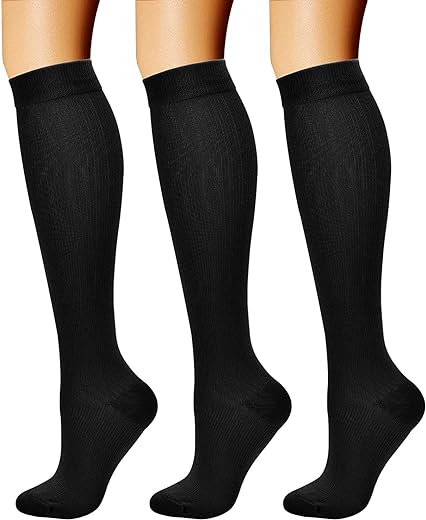
Caring for and washing compression socks is a breeze once you know the right steps! First, turn the socks inside out to protect the compression fabric. Next, wash them in cold water with a gentle detergent. Avoid using bleach or fabric softeners, as these can damage the socks. After washing, gently squeeze out any excess water and lay them flat to dry. It’s important to avoid wringing or twisting the socks to prevent stretching. And here’s a crazy fact: did you know that compression socks were originally developed for astronauts to combat the effects of zero gravity on their legs? Now, with these easy steps, you can keep your compression socks in top-notch condition and enjoy the benefits they provide. Happy washing!
Top-Rated Compression Socks for All-Day Comfort
Step 1: Check the label
- Find the label on your compression socks.
- Read the label carefully for any specific care instructions.
- Note any temperature restrictions or special washing instructions.
- Follow the instructions provided on the label to ensure proper care for your compression socks.
Step 2: Pre-treat stains
To pre-treat stains on your compression socks, start by identifying the stained areas. Take a stain remover or mild detergent and apply it directly to the stains. Then, gently rub the fabric together to work in the product. For example, if you have a coffee stain on your socks, apply the stain remover directly to the stain, and using your fingers, rub the fabric together in a circular motion. This will help break down the stain before washing the socks.
Step 3: Hand wash or machine wash
To hand wash your compression socks, fill a sink or basin with lukewarm water and add a mild detergent. Gently agitate the socks in the water for a few minutes, making sure to clean them thoroughly. If you prefer machine washing, place the socks in a mesh laundry bag to protect them from snags and wash on a delicate cycle. Remember to follow the instructions on the label for the best results.
Step 4: Rinse thoroughly
After washing, thoroughly rinse your compression socks to ensure all soap or detergent residue is removed. Gently squeeze out any excess water to help them dry faster. This step is crucial to prevent skin irritation and ensure the socks maintain their elasticity.
Step 5: Do not wring or twist
Avoid damaging the elastic fibers of your compression socks by refraining from wringing or twisting them. Instead, gently squeeze out any water by pressing the socks against the sink or by using a clean towel. This will help maintain the integrity and effectiveness of your socks. Remember, a gentle squeeze is all you need!
Step 6: Drying
To dry the compression socks properly, lay them flat on a clean, dry towel or hang them up to air dry. Make sure to avoid placing them in direct sunlight or near any heat sources, as this can weaken the fabric and elastic. It is important to never use a dryer, as the high heat can cause the socks to shrink or become deformed.
Step 7: Avoid fabric softeners
To properly care for your compression socks, it is important to avoid using fabric softeners or dryer sheets. These products may leave behind a residue that can negatively impact the elasticity and compression of the socks. Instead, wash your compression socks in mild detergent and cold water, and let them air dry for best results. By following these simple steps, you can ensure the longevity and effectiveness of your compression socks.
Step 8: Store properly
After your compression socks are fully dry, find a clean and dry spot to store them. It’s important to keep them away from direct sunlight to prevent any damage. Neatly fold or roll them up to maintain their shape and avoid wrinkles.
Step 9: Follow replacement guidelines
To ensure your compression socks continue to provide the desired level of support, it is important to follow the manufacturer’s guidelines for replacing them. Compression socks have a limited lifespan and their effectiveness diminishes over time, so it is recommended to replace them according to the manufacturer’s recommendations. By doing so, you can continue to receive the benefits and support that compression socks offer.
Step 10: Consult a healthcare professional
If you have any specific questions or concerns about caring for your compression socks, consult a healthcare professional. They can provide personalized advice based on your unique needs and medical condition. Seek their guidance for proper washing instructions, drying methods, and any other care tips to ensure the longevity and effectiveness of your compression socks.
Final Tips and Takeaways
In conclusion, taking proper care of your compression socks is essential to ensure their longevity and effectiveness. By following the step-by-step instructions outlined in this blog post, such as checking the label, pre-treating stains, and choosing the right washing method, you can keep your socks in top condition. Remember to rinse them thoroughly, avoid wringing or twisting, and dry them properly. Additionally, it’s important to avoid fabric softeners, store them correctly, and follow replacement guidelines. If you have any doubts or concerns, don’t hesitate to seek professional advice. By following these care instructions, you can be confident that your compression socks will continue to provide the support and benefits you need.
Essential Supplies
Keeping your socks fresh
Getting the most out of your compression socks
- Choose the right size: Compression socks come in different sizes, so make sure to measure your calf and ankle circumference to find the right fit. Most brands provide a sizing chart to help you determine the correct size
- Put them on in the morning: It’s best to put on compression socks in the morning when your legs are less swollen. Take your time and start by turning the sock inside out and pulling it up your foot, gradually working it up your calf
- Smooth out wrinkles: Once the compression sock is on, ensure that there are no wrinkles or bunching up of fabric. Smooth out any creases to ensure a comfortable fit and optimal compression
- Wear them throughout the day: Compression socks are most effective when worn consistently. Keep them on throughout the day, removing them only when necessary, such as during showers or bedtime
- Take care of them: To maintain the quality and effectiveness of your compression socks, follow the care instructions provided by the manufacturer. Typically, they can be hand washed or machine washed on a gentle cycle and should be air-dried. Avoid using bleach or fabric softeners
- Remember, if you have any concerns or questions about using compression socks, it’s always a good idea to consult with a healthcare professional or your physician for personalized advice
Everything you need to know about Compression socks
What are the different levels of compression and how do I choose the right one?
When it comes to compression, there are different levels that you can choose based on your specific needs. The two common levels of compression are lossless compression and lossy compression.
Lossless compression is a method that reduces file size without sacrificing any data quality. It achieves this by removing redundant information within the file. This type of compression is commonly used for text-based files, such as documents and spreadsheets. Lossless compression allows for the file to be uncompressed back to its original form without any loss in quality.
On the other hand, lossy compression is a method that reduces file size by permanently removing some data. This compression technique is commonly used for media files, such as images, audio, and video. Lossy compression achieves higher levels of compression compared to lossless compression but at the cost of some data loss. The degree of data loss can be controlled by adjusting the compression settings, such as the level of compression applied.
Choosing the right level of compression depends on the purpose of the file and your specific requirements. If preserving the original quality of the file is essential, then lossless compression would be the ideal choice. However, if reducing file size is a priority and a slight loss in quality is acceptable, then lossy compression can be more suitable.
It’s important to note that the choice of compression level may also depend on the intended use of the compressed file. For example, if you are compressing an image for web use, you might opt for a higher level of compression to reduce the file size and improve loading times, while still maintaining an acceptable level of image quality.
In summary, the different levels of compression available are lossless and lossy compression. The choice between them depends on the type of file, the desired level of data preservation, and the intended use of the compressed file.
Are compression socks only for athletes or can anyone wear them?
Compression socks are not just for athletes; anyone can wear them! While athletes often use compression socks to improve their performance and aid in recovery, these socks are also beneficial for a wide range of individuals. Compression socks can be worn by people who stand or sit for long periods, those who frequently travel, individuals with certain medical conditions like varicose veins or edema, and even individuals looking for additional support during pregnancy. Compression socks work by gently squeezing the legs to enhance blood flow, reduce swelling, and prevent blood clots. So, whether you’re an athlete or not, you can benefit from wearing compression socks to improve your leg health and overall comfort.













Thank you for your suggestion! Using a mesh laundry bag is a great way to protect compression socks during machine washing. We will definitely consider adding it as an alternative method in Step 3.
I’ve found that using a mesh laundry bag to wash my compression socks in the machine helps to protect them and prevent snags. It would be helpful to include this as an option under Step 3.
Could you provide some tips on how to properly store compression socks? I’m always worried about them getting stretched out or losing their shape.
Thank you for your question! Proper storage is important to maintain the shape and elasticity of compression socks. We will definitely include a section on how to store them properly in Step 8 of the guide.
I love the guide, but I was wondering if there are any specific recommendations for replacement guidelines. How often should compression socks be replaced?
Thank you for your feedback! We will make sure to include specific recommendations for replacement guidelines in Step 9 of the guide. It’s an important aspect to consider for maintaining the effectiveness of compression socks.